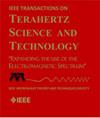Silicon-Micromachined Wideband Sub-THz Frequency-Diverse Antenna
IF 3.9
2区 工程技术
Q2 ENGINEERING, ELECTRICAL & ELECTRONIC
IEEE Transactions on Terahertz Science and Technology
Pub Date : 2025-01-10
DOI:10.1109/TTHZ.2025.3528231
引用次数: 0
Abstract
This article presents the first compact, wideband, silicon-micromachined frequency-diverse antenna, operating across the 220–330 GHz range, designed explicitly for sub-THz imaging applications. The antenna consists of 80 slot radiating elements of twelve distinct sizes corresponding to half of the uniformly sampled wavelengths within the operating bandwidth. These elements are arranged in a Mills-Cross configuration for antenna designs A and B, supported by an innovatively shaped air-filled cavity. The cavity is engineered to support multiple higher-order, high-Q resonance modes, generating highly frequency-diverse, pseudorandom radiation patterns. The frequency-diverse antenna is fed by a three-section impedance-matching transitional direct waveguide and is fabricated using advanced silicon micromachining technology. This article comprehensively analyzes the antenna's radiation patterns and impedance matching across the entire waveguide band. The compact prototype, with an overall size of 18 mm × 16 mm × 0.933 mm (effective antenna dimensions of 11硅微加工宽带次太赫兹分频天线
本文介绍了第一个紧凑,宽带,硅微机械频率变化天线,工作在220-330 GHz范围内,专为亚太赫兹成像应用而设计。天线由80个不同尺寸的狭槽辐射元件组成,这些狭槽辐射元件对应于工作带宽内均匀采样波长的一半。天线设计a和B的这些元件排列成Mills-Cross配置,由创新形状的充气腔支撑。该腔被设计成支持多个高阶,高q共振模式,产生高频多样化,伪随机辐射模式。分频天线采用三段阻抗匹配过渡直接波导馈电,采用先进的硅微加工技术制造。本文全面分析了天线在整个波导波段的辐射方向图和阻抗匹配。紧凑的原型,整体尺寸为18 mm × 16 mm × 0.933 mm(有效天线尺寸为11$\lambda \乘以11\lambda \乘以0.85\lambda$),是迄今为止报道的最紧凑的充气,腔背式频率变化天线。它具有高辐射效率,设计用于直接安装在标准WR-3.4波导法兰上。该天线的分数带宽为34%,回波损耗优于10db,扩展到40%,回波损耗优于5db。
本文章由计算机程序翻译,如有差异,请以英文原文为准。
求助全文
约1分钟内获得全文
求助全文
来源期刊

IEEE Transactions on Terahertz Science and Technology
ENGINEERING, ELECTRICAL & ELECTRONIC-OPTICS
CiteScore
7.10
自引率
9.40%
发文量
102
期刊介绍:
IEEE Transactions on Terahertz Science and Technology focuses on original research on Terahertz theory, techniques, and applications as they relate to components, devices, circuits, and systems involving the generation, transmission, and detection of Terahertz waves.
 求助内容:
求助内容: 应助结果提醒方式:
应助结果提醒方式:


